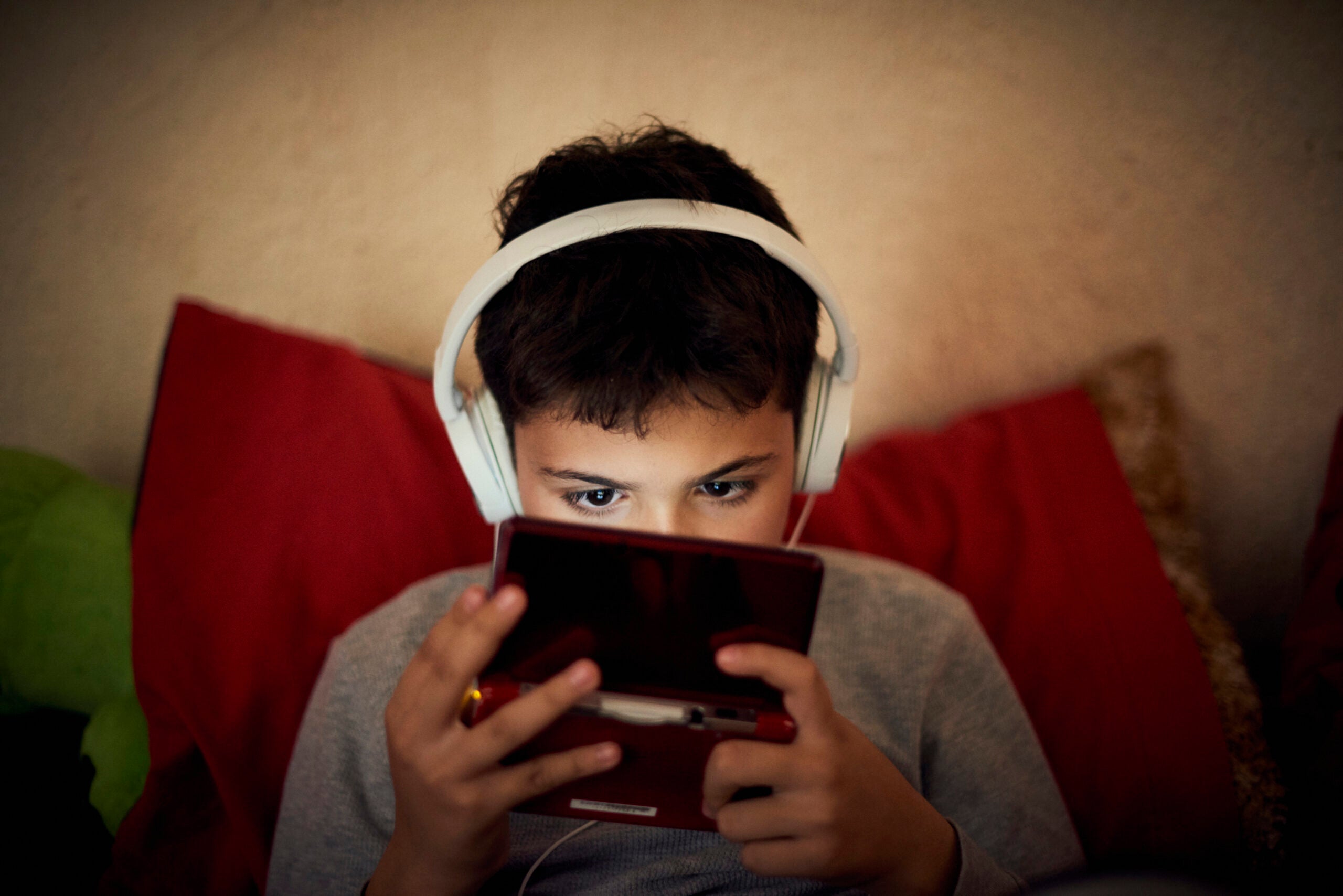Key findings
- As of Q3 2023, internet users spent six hours and 40 minutes online daily
- Children aged 8 – 10 years old spend about six hours a day in front of a screen using entertainment media, and children aged 11 – 14 spend nearly nine hours a day in front of a screen.
- Around the world, people spend more than 40% of their waking hours looking at screens.
65.7% of the world’s total population uses the internet, and today more than ever these internet users are spending their time online for entertainment purposes. As the average time spent online increases year after year, it’s raised questions about screen time and its consequences.
How much screen time is too much? What are the consequences of too much screen time and how do you manage it? Should children’s screen time be limited? We’ll answer these questions and more so you can be better informed of the reality of screen time in today’s digital age.

The pandemic led to increased screen time trends
It’s no surprise that COVID-19 brought about many changes to our online habits. Quarantining led to an increase in screen time in both children and adults all over the world, and these trends have continued post-pandemic.
During COVID-19, the average screen time for American adults increased by over 60%, and overall adult screen time increased to over 13 hours a day.
Children also began to spend more time online, with average daily screen time increasing by two hours during the pandemic. Perhaps even more significant is the continuation of these trends. While kids’ screen time increased during the pandemic, it has stayed that way.
The continued high screen time tendencies among children and adults have led to questions regarding the consequences of prolonged time in front of screens every day – and it’s safe to say we are spending far too much time online than recommended.
Screen time in the U.S.
The recommended screen time for adults is no more than two hours per day, but the average American aged 16 – 64 spends over seven hours per day online. The global average is six hours and 40 minutes.
Compared to South Africa, which has an average of nine hours and 24 minutes spent online, America falls in the middle of the pack. But looking at Japan, which has the lowest average time spent online at just three hours and 56 minutes, it’s clear the U.S. has a long way to go until it’s closer to the recommended amount of time spent online.
Screen time by age
As expected, the younger the age, the more time spent online. Older generations that did not grow up with the technology of the younger generations are naturally less inclined to spend hours and hours on social media and other entertainment applications.
According to Data Reportal’s 2024 global report, females aged 16 – 24 spend the most time online daily at seven hours and 32 minutes. The most time spent online by males falls within an older age group of 25 – 34 years old at seven hours and 13 minutes.
The age group with the lowest screen time is males and females aged 55 – 64 years old. Females in this group spend an average of five hours and seventeen minutes online while males spend an average of five hours and fourteen minutes online daily.
Regardless of the lower screen time trends in older adults, five hours is still well above the recommended two hours per day, but in general, the older a country’s population is as a whole, the less time that country will collectively spend online.
Increased screen time in children
Image credit: Centers for Disease Control and Prevention
Increased screen time amongst children has persisted in the years since the pandemic. According to the Centers for Disease Control and Prevention (CDC) children aged 8-10 spend an average of six hours per day in front of a screen using entertainment media, and nearly four hours of this time is spent watching television.
Children aged 11-14 spend nearly nine hours per day in front of a screen and five of those hours are spent watching television.
According to the Mayo Clinic, no screen time is recommended for children under two years old, and for children aged 2 – 12, one hour per day is recommended. For teens and adults, two hours per day is recommended.
Consequences of excessive screen time

Spending too much time looking at a screen can have consequences. According to the National Institute of Drug Abuse, too much screen time can result in:
- Trouble sleeping – Bright screen lights can reduce melatonin release at night time, keeping you awake.
- Mood changes – Too much time online can affect your emotional health
- Brain alterations – Too much screen time at a young age can alter your cortex, the part of the brain that processes information.
Excessive screen time in kids can also lead to developmental issues, resulting in social-emotional developmental problems, increased anxiety, impaired emotional comprehension and hindered social and emotional competence.
Managing screen time
Do you think your screen time is too high? There are ways to manage it in order to mitigate possible negative effects.
- Check your screen time on your device – You can find out how much time you’ve spent on your device in your settings. Learning about how long you typically spend online or staring at a screen can give you a good place to start when trying to manage your screen time.
- Resist screen time when you are bored, distracted or stressed – Grabbing your phone or turning on the TV can often be a default method of spending your time when you find yourself distracted, bored or stressed. Next time, consider whether screen time is what you really need and think of alternative ways to spend your time.
- Don’t use your devices while you eat – Even eliminating electronics while you eat your meals can help you manage your daily screen time.
- Designate screen-free times during your day – Blocking out specific times of your day with no screens, like one or two hours before bed or when you wake up can help you build more healthy habits towards screen time.
- Consider alternatives to screen time – Instead of immediately reaching for a screen, consider alternate activities such as reading, exercising, spending time with friends, etc.
You can also check out some apps that limit screen time for you or your family:
- RescueTime – RescueTime tracks the time you spend on apps and websites, allowing you to better manage your screen time.
- Qustodio – A parental control app that can limit screen time by blocking or limiting time spent on apps.
- Bark – Bark is another parental control app that can create app and web time rules for different times of the day.
- iOS Screen time – Apple’s built-in screen time limiting app in settings can help you track your screen time and set usage limits without having to download other apps.
- Space – Space helps you set goals so you can be more mindful about your time spent online.
See Allconnect’s News and Research hubs for more broadband guides and information.
Screen time FAQs
Teenagers spend an average of seven hours and 22 minutes staring at a screen per day, not including time spent working on school and homework.
Start by tracking your screen time in your device settings. You can also use screen time managing apps to limit your usage and practice good daily habits around your electronic devices.
Children under two years old shouldn’t have any screen time, while children aged 2-12 are recommended one hour per day. Its recommended that teens and adults have no more than two hours of screen time per day.

Written by:
Camryn Smith
Cammy is a writer with Allconnect, growing her broadband industry knowledge for over a year on the internet marketplace. Her expertise lies in home internet and broadband service with a focus on providers, plans…
Read more
Edited by:
Robin LaytonEditor, Broadband Content
-
Featured
![5 of the best parental control apps to keep your children safe online]() 5 of the best parental control apps to keep your children safe online Robin Layton — 2 min read
5 of the best parental control apps to keep your children safe online Robin Layton — 2 min read -
Featured
![Discover the benefits of online entertainment]() Discover the benefits of online entertainment Robin Layton — 3 min read
Discover the benefits of online entertainment Robin Layton — 3 min read -
Featured
![Report: Internet users are gobbling data by more than a half-terabyte]() Report: Internet users are gobbling data by more than a half-terabyte Robin Layton — 4 min read
Report: Internet users are gobbling data by more than a half-terabyte Robin Layton — 4 min read
Latest
-
Thursday, July 25, 2024
Worried about losing your signal? This is how to keep your satellite dish cleanDavid Anders — 6 min read
-
Tuesday, July 23, 2024
The best free TV and movie streaming services 2024Camryn Smith — 5 min read
-
Tuesday, July 23, 2024
Everything you need to know about internet speedsRobin Layton — 8 min read







